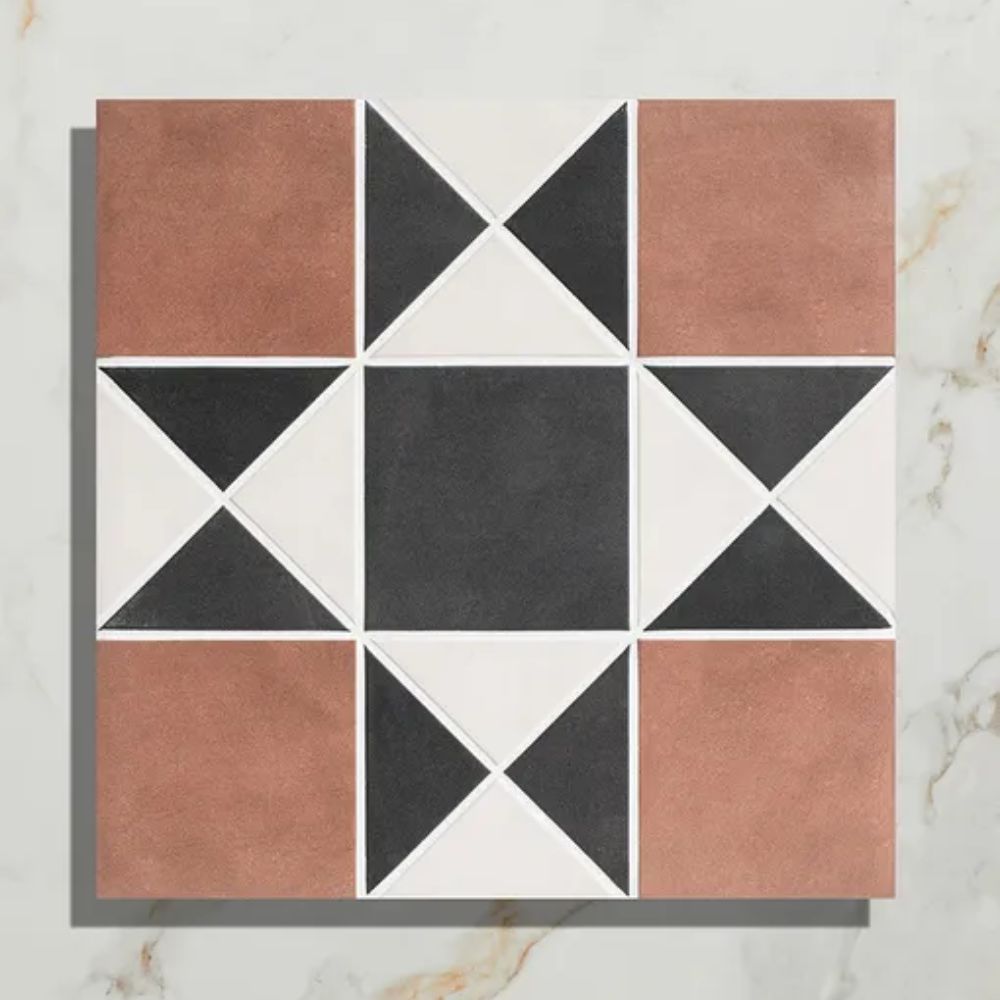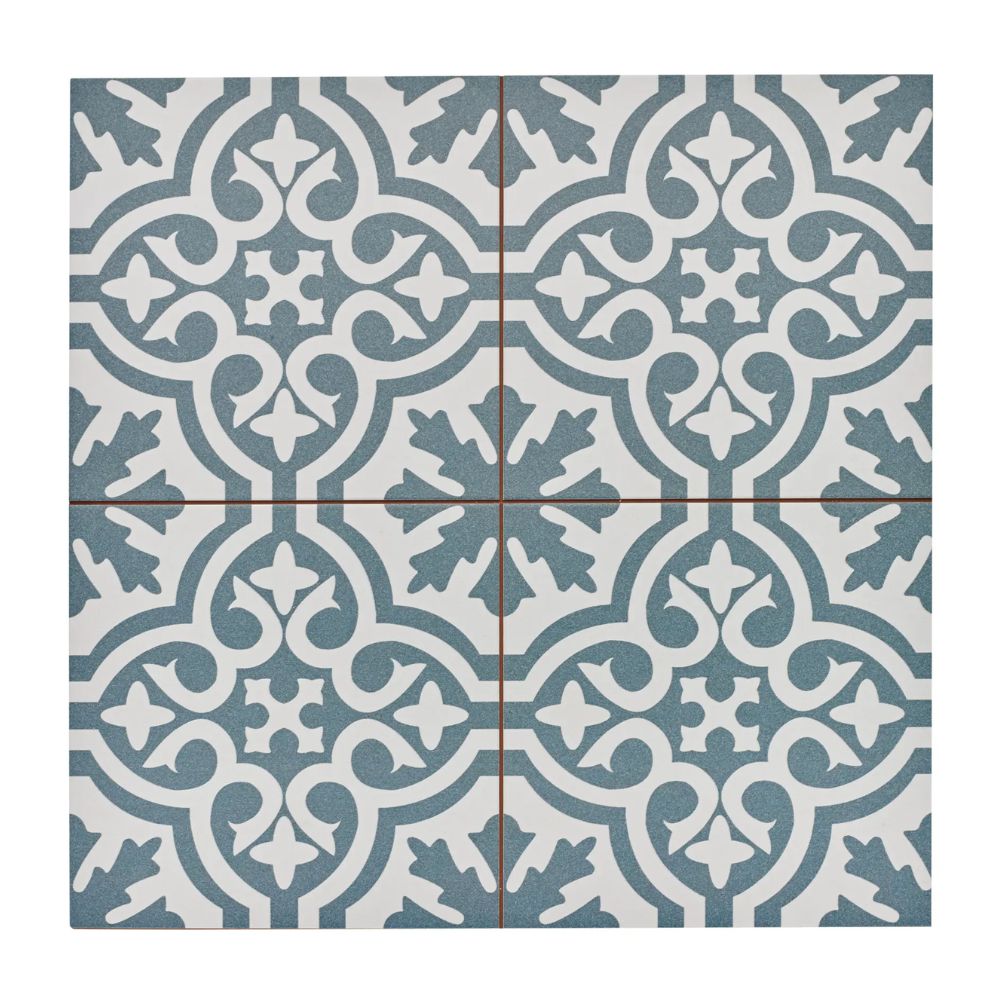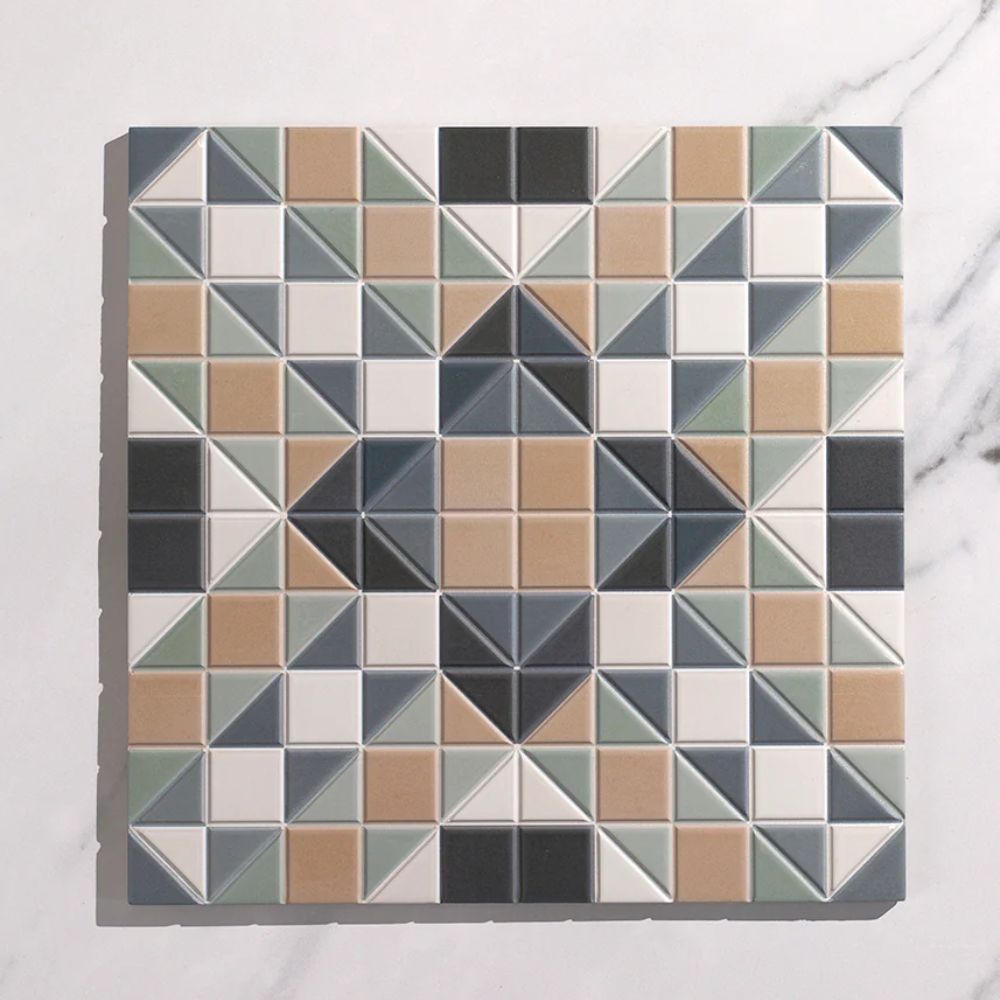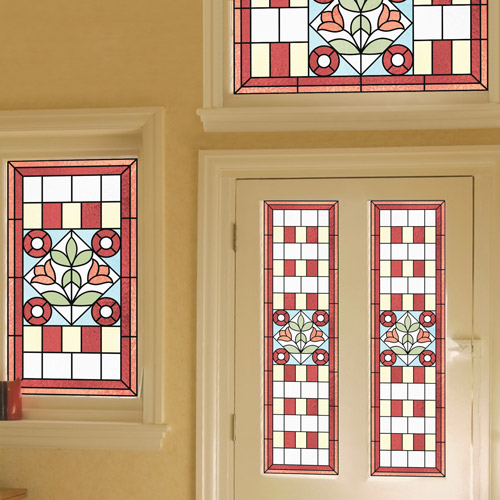19 Victorian hallway ideas to transform narrow spaces into show-stopping entrances
These Victorian hallway ideas are full of clever ways to honour your home’s heritage while keeping things beautifully up to date
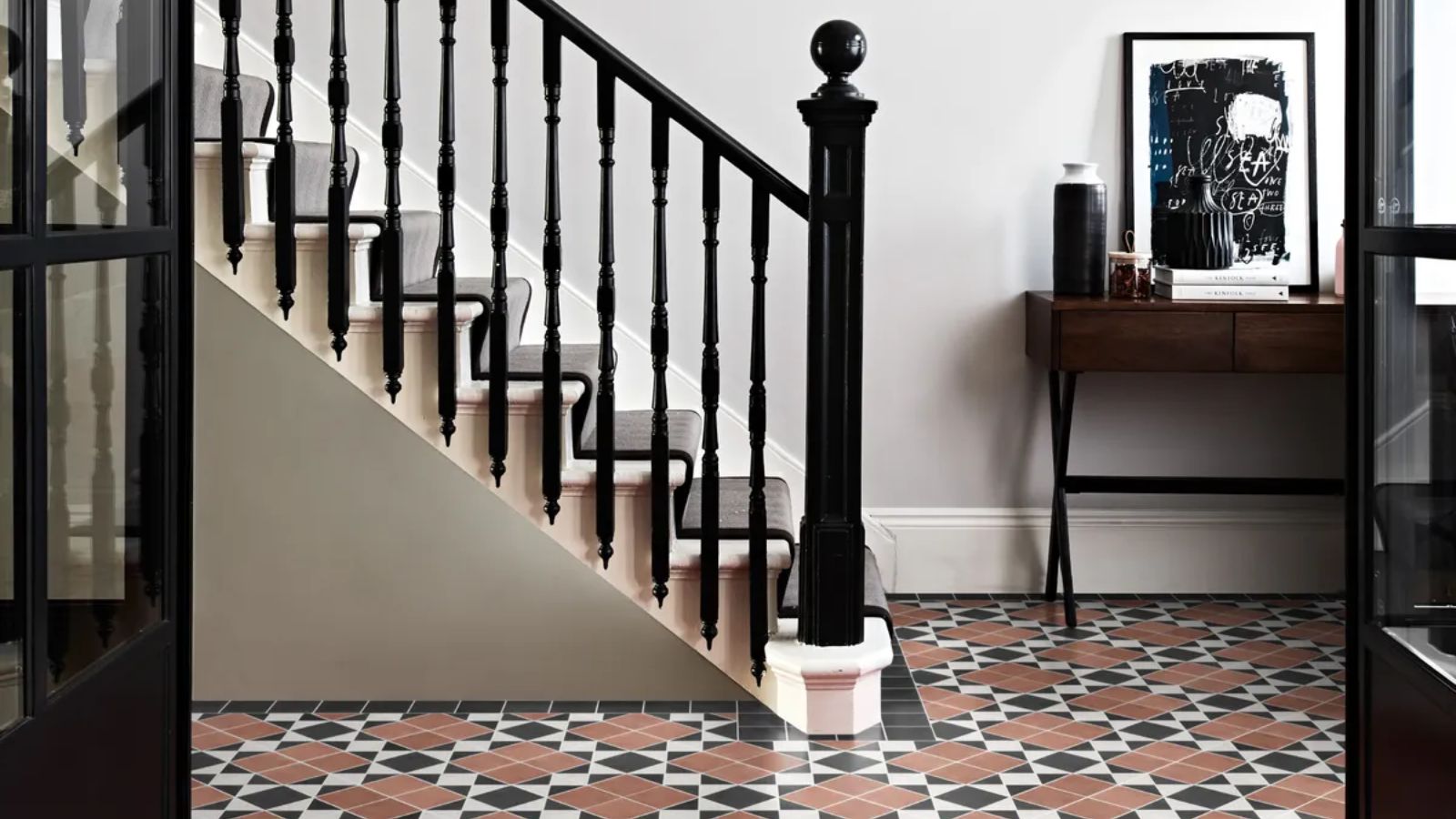
Victorian hallways might be narrow, but what they lack in width they more than make up for in period charm. With original cornicing, geometric floor tiles, high ceilings, and beautifully panelled staircases, these spaces offer a wealth of design potential just waiting to be unlocked.
Whether you're renovating a Victorian house or updating a period semi, your hallway sets the tone for the rest of your home. It's often the first thing guests see, and with some clever design choices, it can feel both welcoming and true to its heritage. From flooring to lighting, this is your chance to highlight original features while layering in smart updates that work for modern life.
We asked interior designers to reveal their favourite Victorian hallway ideas, from clever space-saving solutions to styling tips that celebrate the home's original charm.
Victorian hallway flooring ideas
1. Bring back classic checkerboard floors

According to Jenna Forsdyke, senior interior designer at Pfeiffer Design, checkerboard tiling remains a favourite choice in period properties for good reason:
“A defining feature of Victorian homes is classic checkerboard tiles – a style which has remained popular even in contemporary hallway design,” she says. “But staying sympathetic to this look doesn’t necessarily mean you have to stick with the monochrome palette. Introduce warmth with a rustic coloured tile paired with white to create that traditional pattern with a difference.”

Jenna Forsdyke is Senior Interior Designer at Pfeiffer Design, specialising in timeless, client-focused interiors that blend practicality with personality across residential and commercial projects throughout the UK.
2. Stick with original Victorian floor tile designs for sympathetic statement look
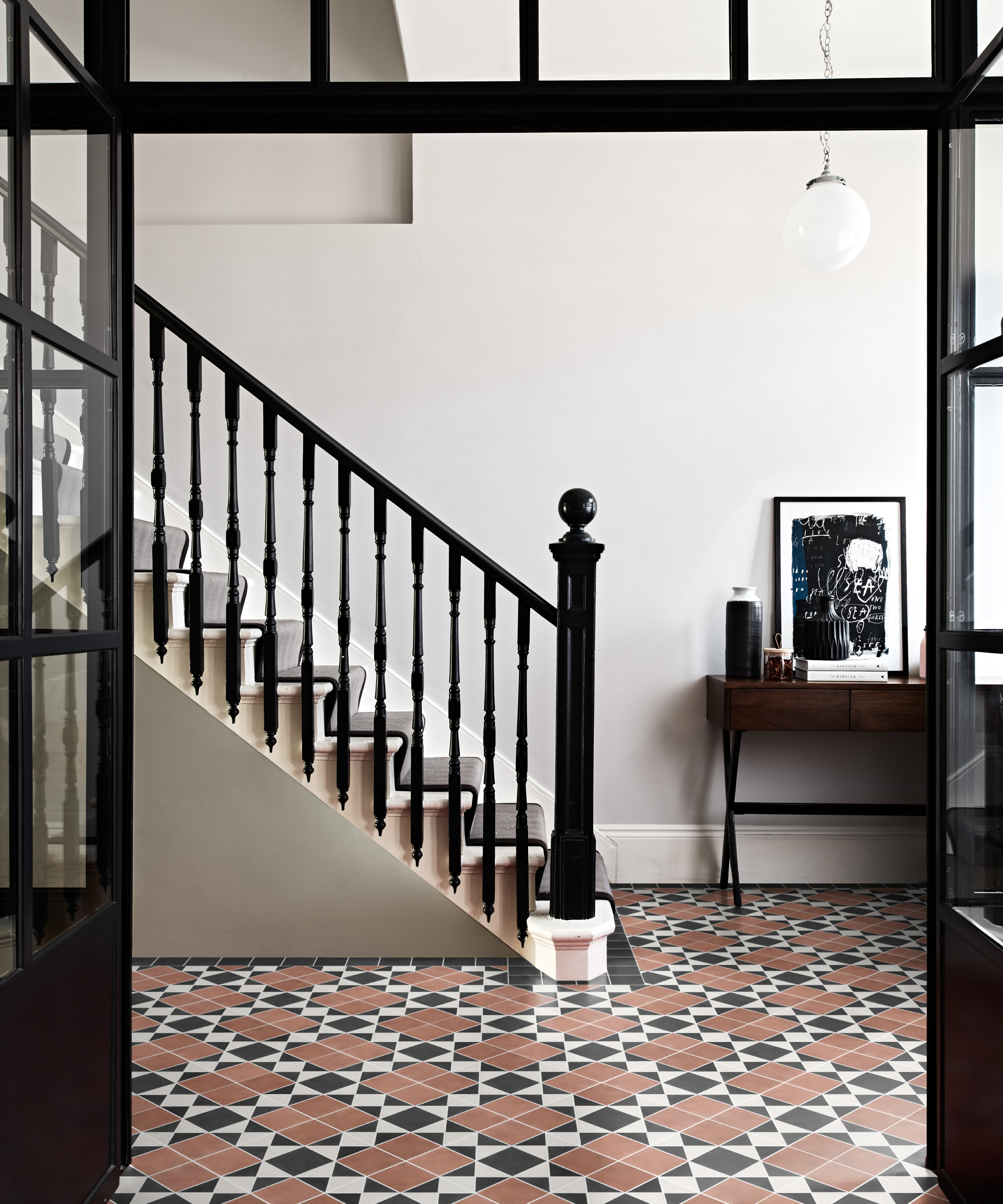
Highly patterned floor tiles are a hallmark of Victorian hallways, often forming the centrepiece of these spaces with their bold geometric motifs. Whether laid in traditional red, black and white or more intricate encaustic designs, they offer a strong visual link to the period and make a striking first impression.
“I think the flooring is a really important element in a Victorian hallway – it can be the showstopper piece in the space,” says Sophie Clemson, co-founder of The Living House. “Victorian hallway flooring is known for being patterned, and if you have the original Minton tiles then wow, you're very lucky!”
Bring your dream home to life with expert advice, how to guides and design inspiration. Sign up for our newsletter and get two free tickets to a Homebuilding & Renovating Show near you.
But if you don’t have original tiles, don’t fret – there are plenty of high-quality modern alternatives available that closely echo authentic Victorian patterns and colour palettes:
3. Take advantage of wooden floorboards
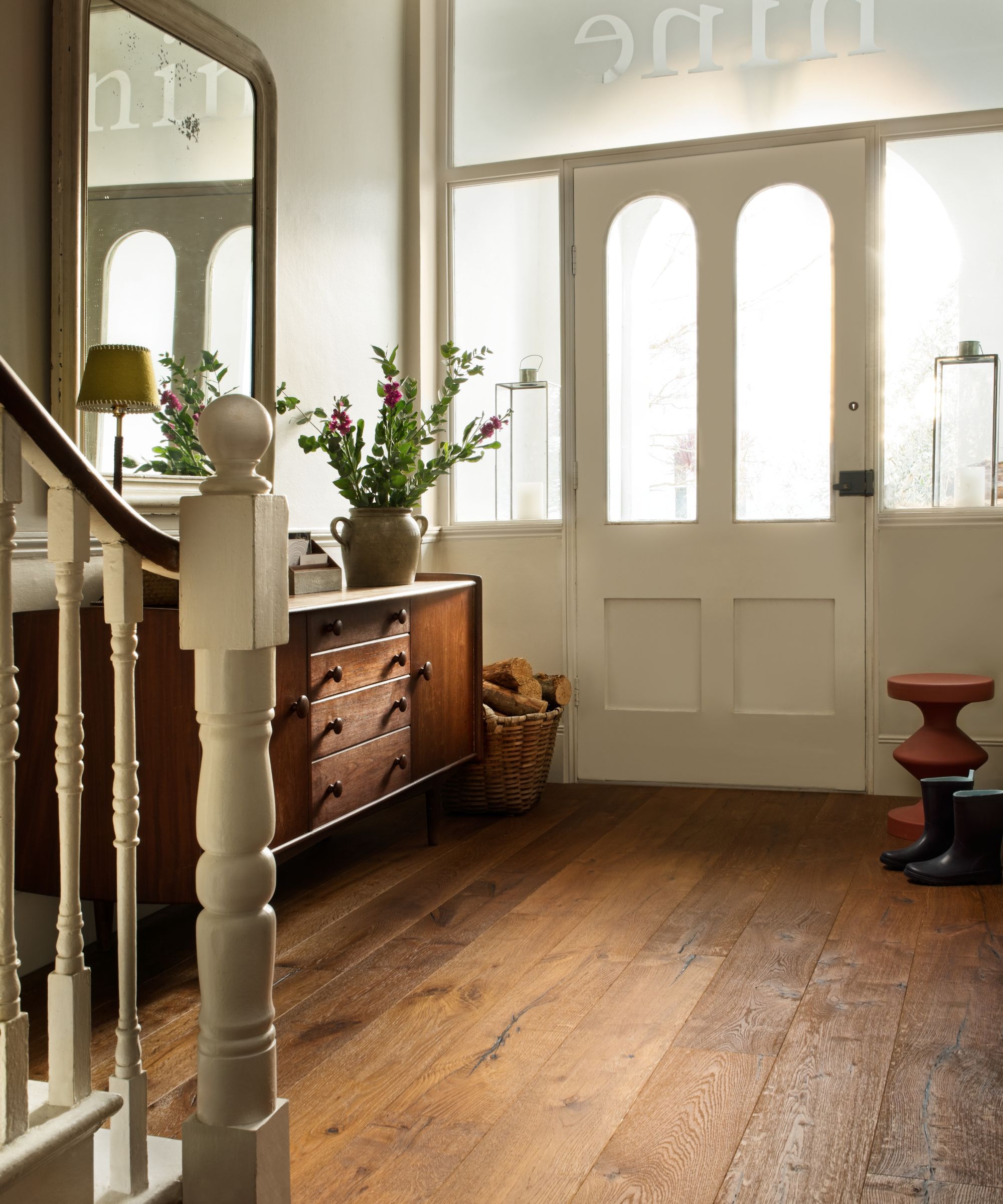
There’s something effortlessly elegant about wooden floors in a Victorian hallway, and if you suspect there’s original timber hidden beneath old carpet or vinyl, it’s well worth lifting a corner to investigate!
“If you’ve currently got carpet, it’s always worth having a peek beneath it,” says Melissa Denham, interior designer at Hammonds Furniture. “You might uncover original wooden floorboards or even elegant parquet. Simply sanding these down, resealing and painting them will reveal their natural beauty and make a big difference to the space.”
And if the existing boards are beyond repair? There are still options that remain true to the Victorian aesthetic. “Engineered wood flooring is an ideal choice for a hallway,” says Natalie Mudd, creative director & co-founder of Knot & Grain. “It offers a timeless look and hardwearing properties, while acting as a natural insulator to help with heat loss – a common issue in period homes.” She recommends aged dark wood with plenty of grain and variation to enhance the feeling of warmth and authenticity.

Melissa has almost two decades of experience designing and delivering interior projects. Her clients have been varied, from large retailers to independent businesses or those who want vision in creating their dream space.

Natalie Mudd is the Creative Director and Co-Founder of Knot & Grain, specialising in premium engineered wood flooring designed to celebrate natural materials and enhance characterful, design-led interiors.
4. Make a statement with painted floors and stairs
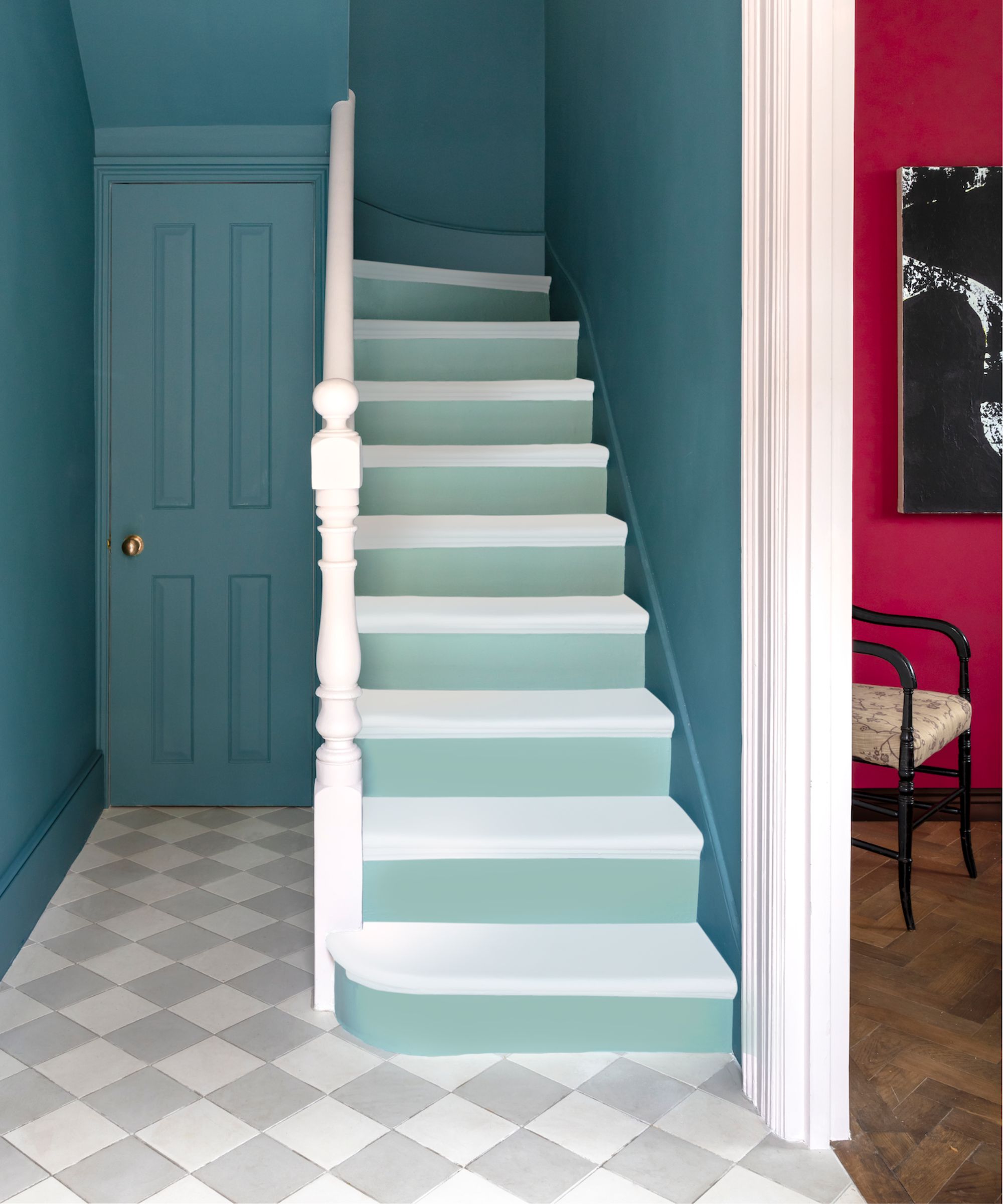
If your hallway doesn’t have original tiling or parquet floors, painted floorboards or stairs are a brilliant alternative. Not only are they cost-effective and easy to update, they also let you get creative with colour in a space that’s often overlooked.
In this hallway, decorated by Craig & Rose, the staircase becomes a feature in itself thanks to soft mint green risers and white treads, perfectly complemented by rich teal walls. It’s a bold look, but the tonal palette keeps it cohesive and calm. Painted stairs are also great for adding contrast and interest in a narrow hallway – just make sure you choose a tough, non-slip floor paint with a satin or eggshell finish for durability.
5. Add warmth underfoot with hallway and staircase runners
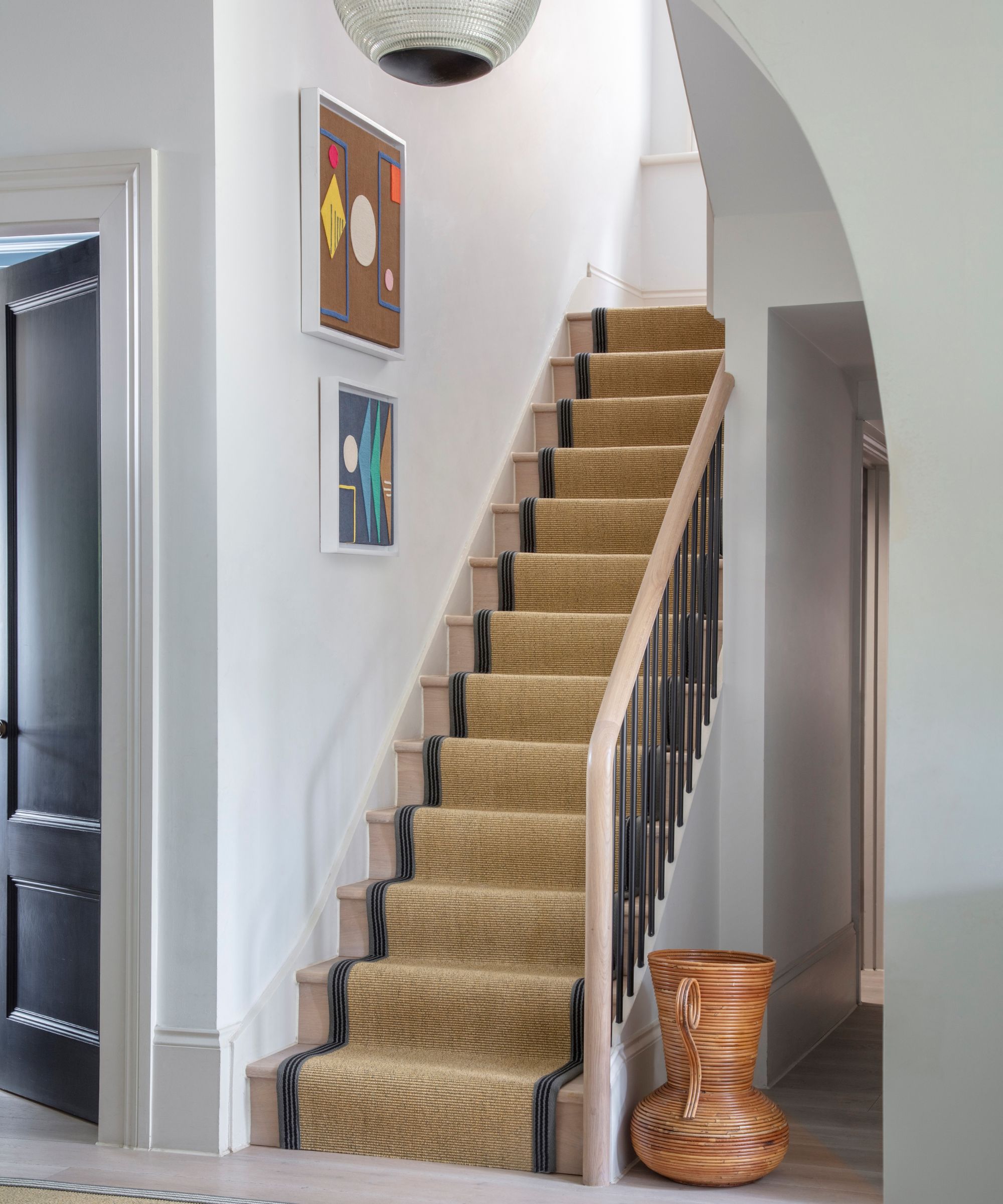
"A stair runner is the perfect touch for a Victorian hallway, instantly making a statement the moment guests arrive," says Kirsty Barton, brand storytelling manager at Alternative Flooring . "More than just a beautiful design, stair runners are also both practical and hardwearing, making them ideal for busy households, whilst preserving original features."
For a timeless yet eye-catching style, Kirsty recommends choosing a sisal runner with a bold border for a pop of colour, or a wool, patterned carpet that's custom fit for a grand staircase. “Derived from sustainable plant fibres, natural carpets made from 100% wool, sisal, jute, coir, and seagrass complement the authentic look and feel of period properties beautifully," she adds. "The intricate weaves and natural shades are sympathetic to the aged materials found in historical homes while providing a hardwearing and long-lasting flooring option."

Kirsty has been working at Alternative Flooring for over 20 years. She has been instrumental in shaping Alternative Flooring's brand identity and is committed to the company's core pillars: people, product, and planet
Victorian Hallway Storage Ideas
6. Make the most of the space under your stairs with built-in storage
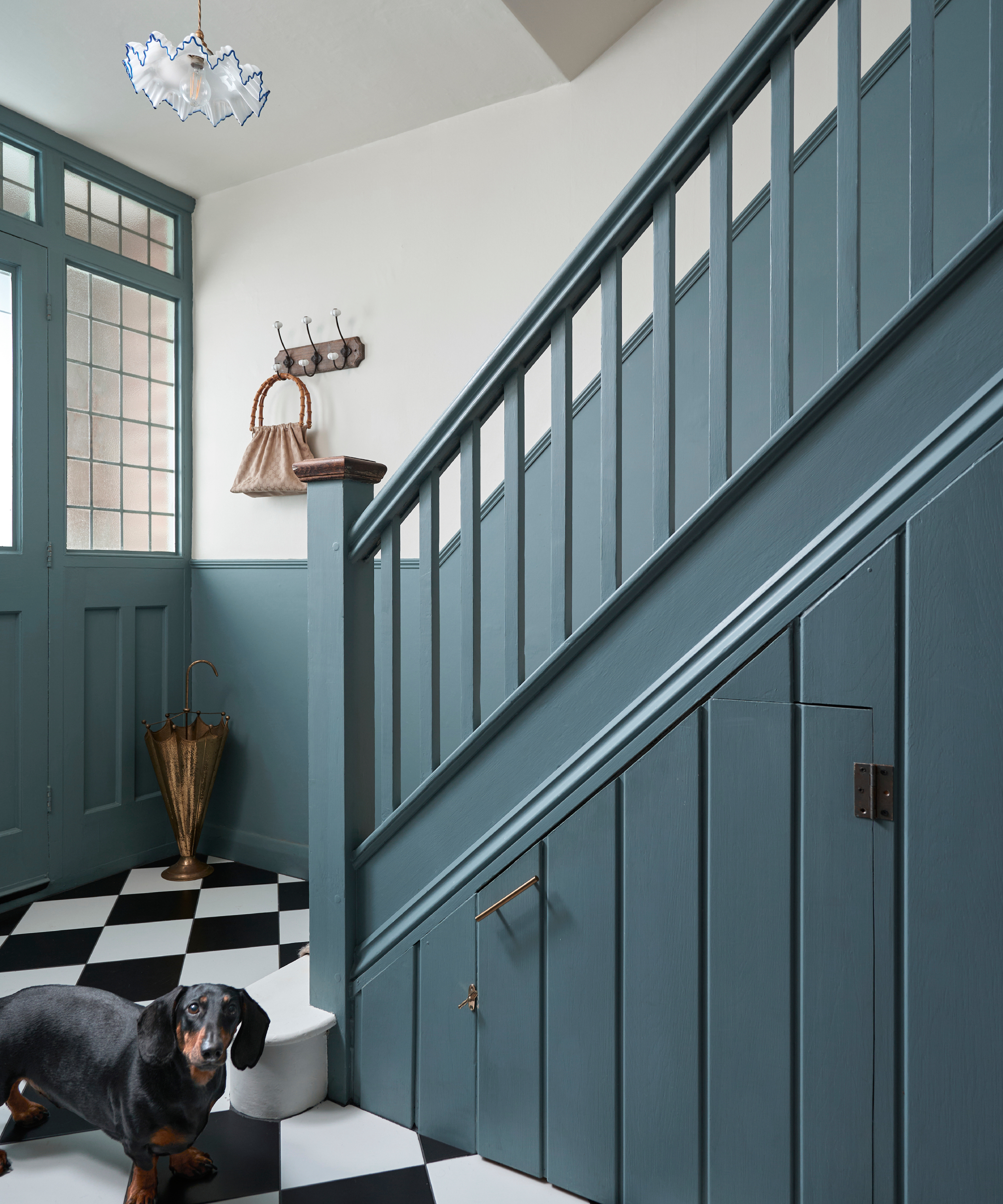
“In narrow Victorian hallways, storage has to work hard without overwhelming the space,” says Darren Morley, MD at The Mirror Man. “One trick I always use is building in shallow panelling or wall mouldings that double as hidden cupboards or shoe storage. It blends with the original features so it doesn’t feel out of place, but still gives you somewhere to stash daily clutter.”
"Another way you can incorporate storage in your home entrance, without taking up floorspace, is to utilise the space under the stairs," adds Melissa Denham. "Fitted wardrobes can be cleverly designed for this awkward space, giving you ample room to store shoes, bags, coats, and more."

Darren Morley, Managing Director of The Mirror Man, stands as a pertinent expert on styling Victorian hallways due to his extensive interior design expertise, especially in incorporating decorative mirrors and art that can enhance light and space, aligning perfectly with the intricate aesthetics of Victorian interiors.
7. Add slimline storage units that double as seating or decorative furniture
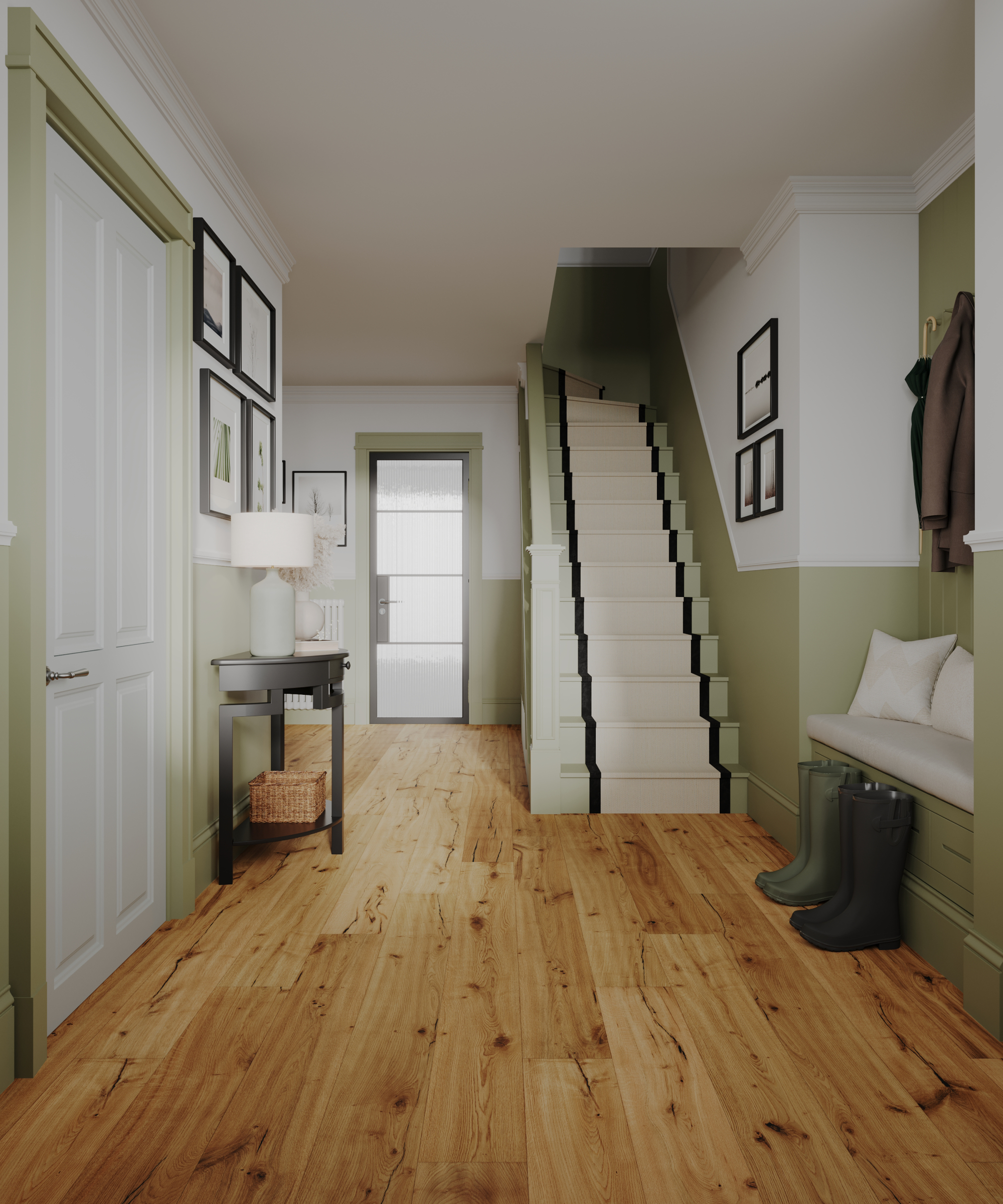
"Victorian entrance halls are rarely spacious, so I’m careful not to crowd them," says Keely Smith, lead interior designer at JD Elite interiors. "Tall, built-in cupboards that blend with panelling can hide away clutter without drawing too much attention. I also like using slim benches with hidden compartments or vintage-style coat hooks that match the hardware finishes. Even small ledges for post or keys can go a long way in keeping the space functional without looking busy. It’s all about making the most of the vertical space and choosing pieces that look like they belong."

Keely Smith is the lead interior designer at JD Elite interiors. She has over 10 years of experience working with design studios, private companies, and as a freelance designer. Keely specialises in creating custom, client-centered spaces that blend functionality with timeless style. Her work has been featured in several regional design showcases, earning praise for both creativity and attention to detail.
8. Install a feature peg wall for additional storage
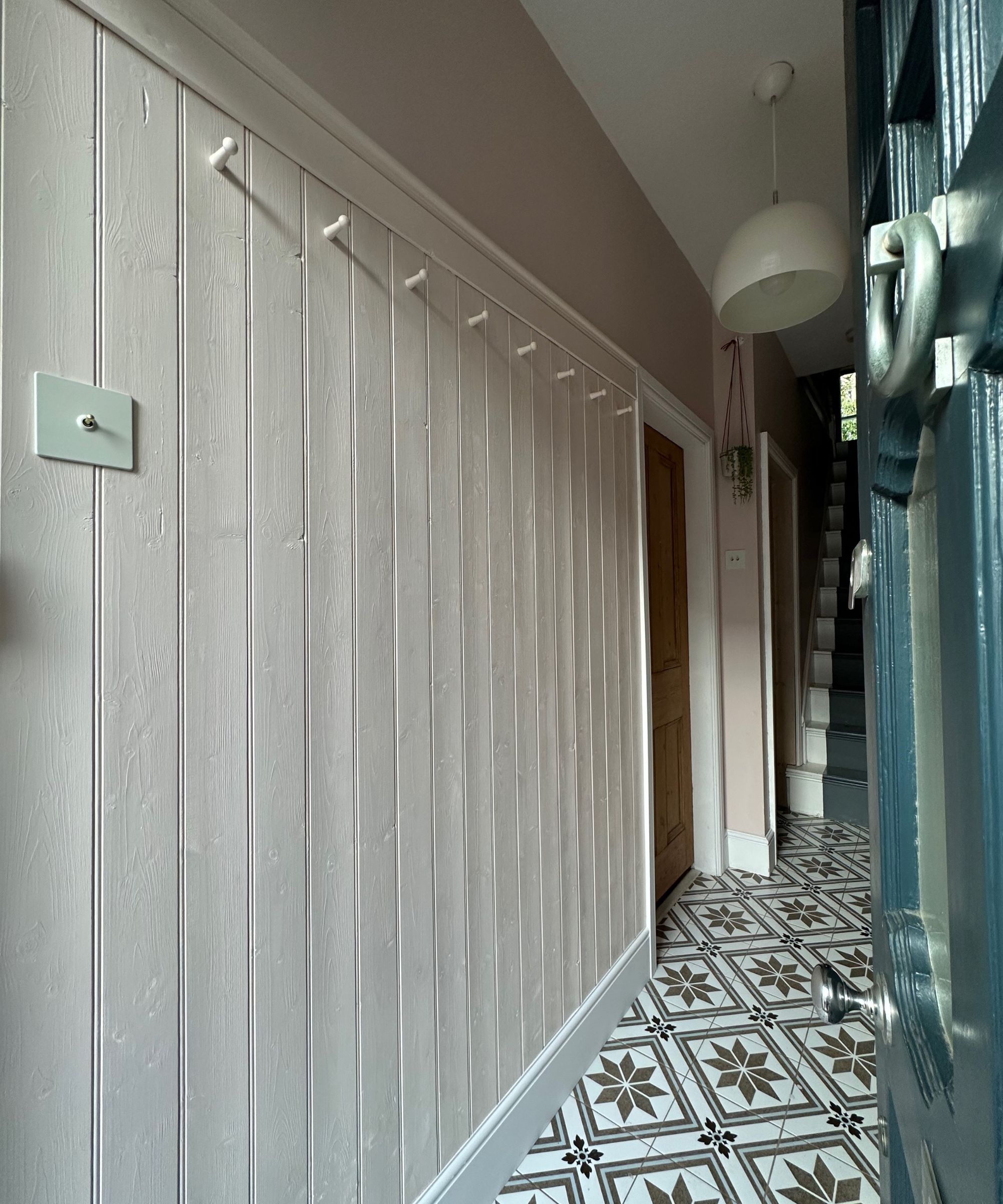
"Installing hallway wall panelling is great way to bring out the character of a period property," says Richard Bradley, UK head of marketing at V33. "You can also use it to introduce zoned colour areas or – if matching panelling with walls tonally – impart texture. Panelling is also useful for concealing damaged wall surfaces and unsightly pipework.”
“Once panelling is installed, it’s important to choose a finish that’s both beautiful and practical to ensure it stays looking good over time,” adds Richard. "Go for paint that needs no undercoat, so that the final part of creating your new wall panelling is as easy as possible. Something hardwearing and ultra-washable that has really high adhesion would be my choice."
9. In narrow spaces, the console table is king

Console tables more than earn their place in compact hallways. They add structure, offer a handy spot for post or keys, and give you space to style a lamp or some flowers. Melissa Denham at Hammonds Furniture, agrees: “Console tables allow you to hide away the smaller things like umbrellas, keys and post, as well as giving the option to decorate the surface with pretty lamps, photo frames and floral displays.”
Victorian Hallway Paint & Panelling Ideas
10. Go all out with bold contrasting shades
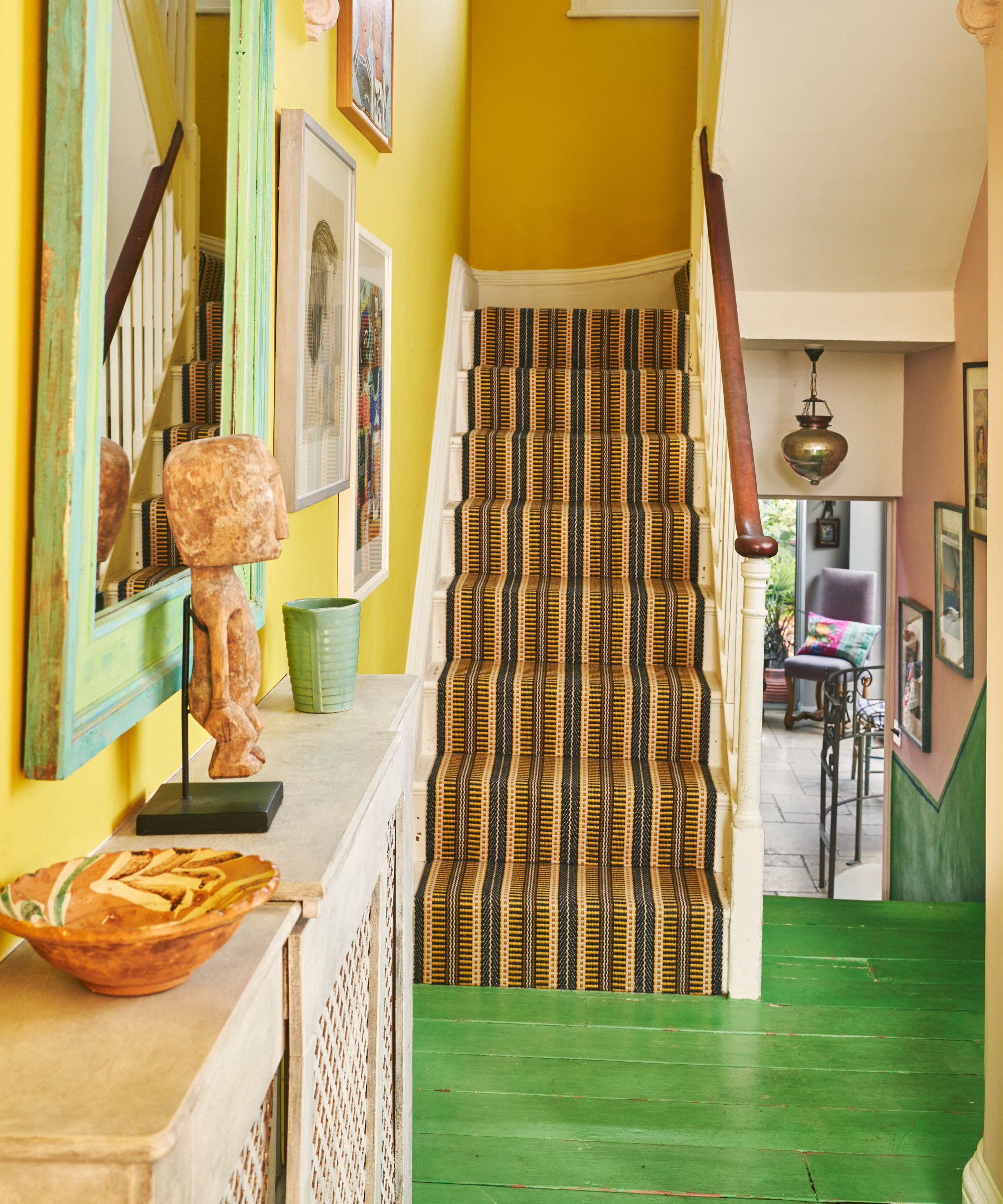
Who says Victorian hallways must always play it safe? Darker or enclosed layouts are often the perfect canvases for experimenting with rich, unexpected colour combinations.
This vibrant design by Annie Sloan is a masterclass in colour confidence. A sunshine yellow wall contrasts the punchy green-painted floor, layered with pattern and eclectic accessories for a scheme that’s bold but balanced. Surprisingly, the bright hues work with – not against – the home’s original details, such as the stair spindles and high skirting.
If you’re nervous about using strong colours, consider keeping woodwork or panelling white to create breathing space, or pick one vivid tone and echo it in smaller accents like runners or artwork to tie the look together.
11. Let there be light – embrace 'white on white'
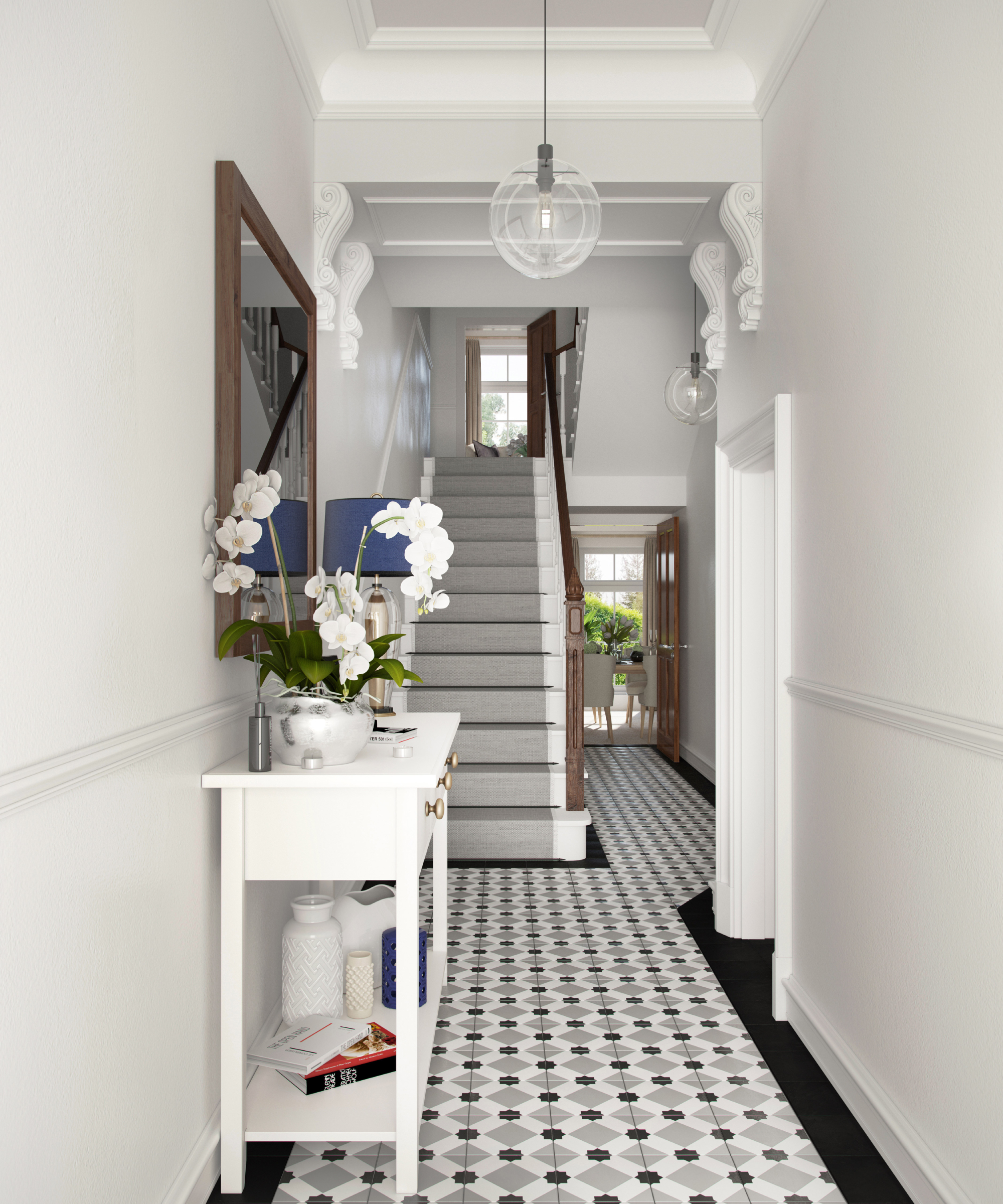
Layering soft whites is a brilliant way to lift a darker Victorian hallway and make the most of any natural light. Whether you go for warm cream tones, chalky off-whites or bright, gallery-style finishes, this approach brings a sense of calm and clarity, without distracting from beautiful period features like ceiling roses, corbels or cornicing.
But before you start prepping your walls Emma Bestley, creative director at YesColours, explains the importance of selecting the right type of paint for high-traffic areas: “The hallway is a high-traffic area and in narrow homes like a Victorian property it’s important to use a wipeable high-quality matt finish paint. Using a durable eggshell on wooden staircases and skirting boards will help to keep these frequently used surfaces smarter for longer.”
12. Heighten the drama with dark, moody shades
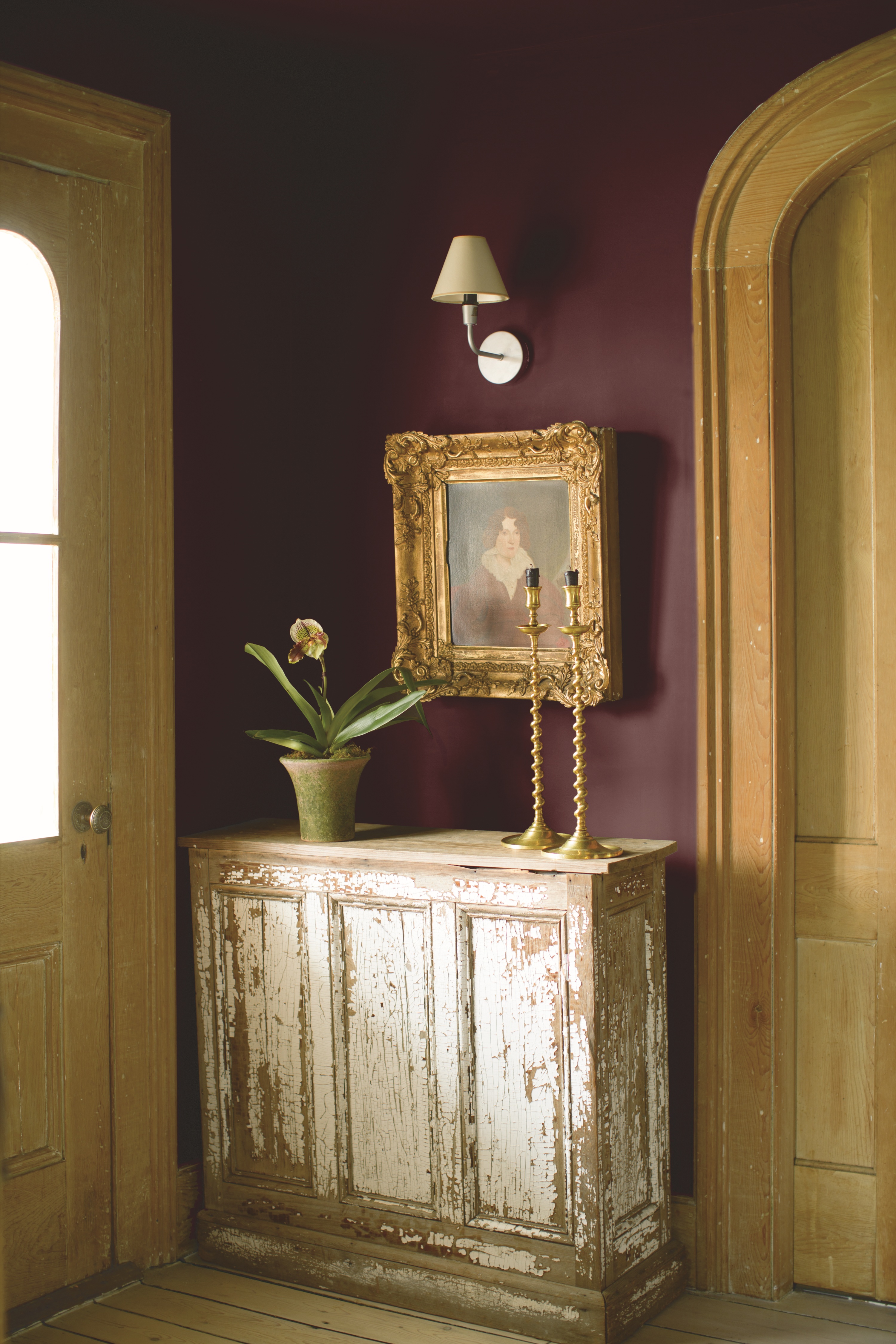
Dark walls might feel like a bold move, but they work surprisingly well in Victorian hallways – especially if you’re looking to create a sense of drama, depth and intimacy. Shades like deep plum, forest green or charcoal grey lend richness to these historic spaces and highlight period details like mouldings, skirtings and architraves.
Ally Dowsing-Reynolds, co-founder and interior expert at Dowsing & Reynolds, recommends embracing the deeper tones associated with these 1800’s interiors: “The Victorians typically used rich colours with lots of depth, so incorporating these shades into your hallway is a lovely nod to those original designs.”
“Rich, dark shades of blue and green are especially reminiscent of the Victorian era, bringing a touch of drama and sophistication to your hallway. You can balance these bold shades with more neutral colours like creams, or taupes to prevent the space from feeling too heavy.”

Ally Dowsing-Reynolds is an interior design expert and co-founder of lighting company, Dowsing & Reynolds. She is known for her bold, characterful style and ability to blend contemporary flair with period charm.
13. Colour-drench your hallway, cornicing and all
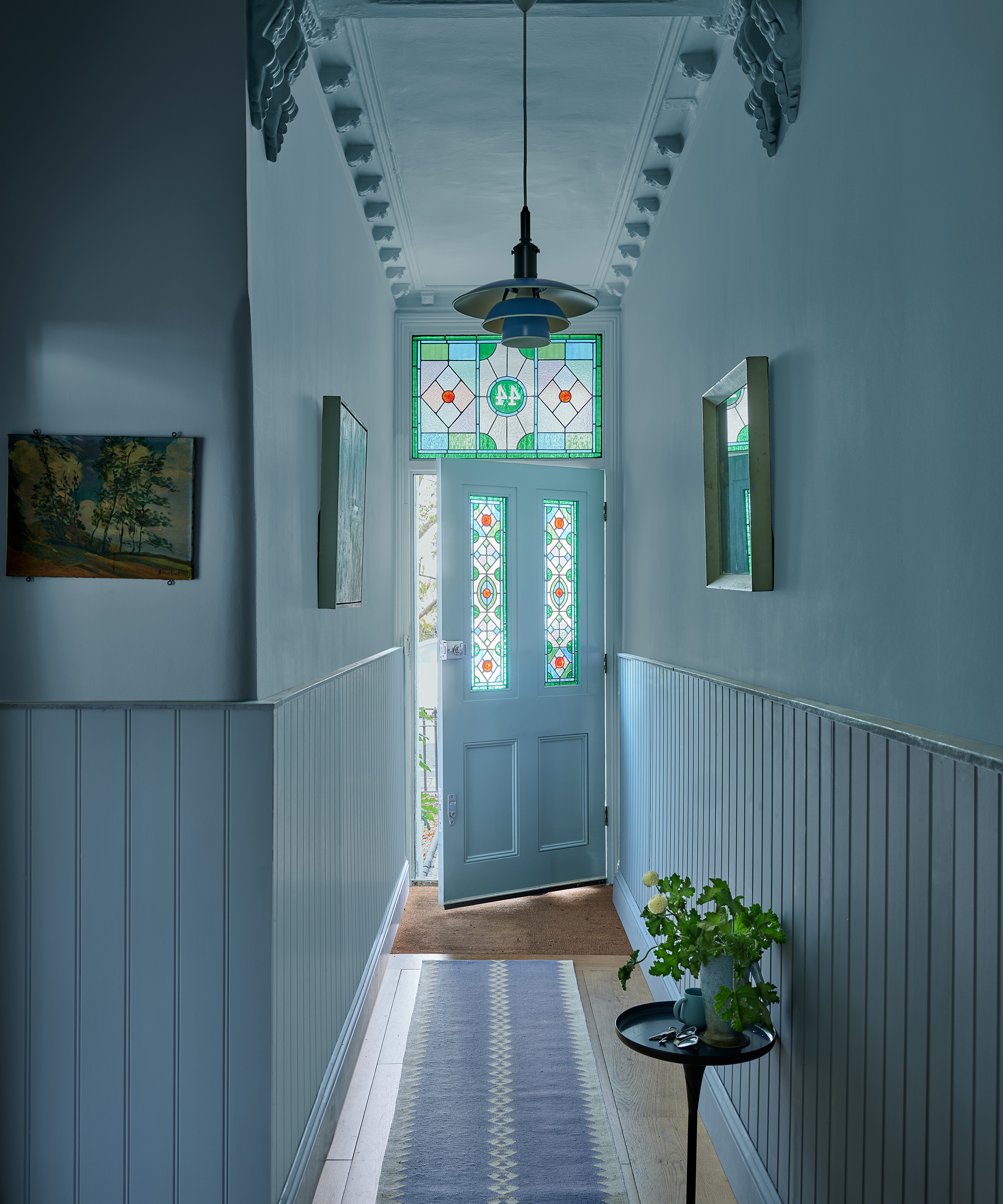
Painting walls, woodwork and even ceilings in the same shade – a technique known as colour drenching – can completely transform a small hallway. Rather than making a narrow space feel boxed in, it creates a cocooning effect that actually helps blur visual boundaries and emphasise a rooms height.
Ally Dowsing-Reynolds shares here advice: “If your hallway ceiling is lower, there are many ways to draw attention upwards. Colour drenching your wall and ceilings in the same shade is a great way to give the illusion of a higher space.”.
Victorian Hallway Lighting Ideas
14. If height allows, use statement pendant lighting to draw the eye upwards
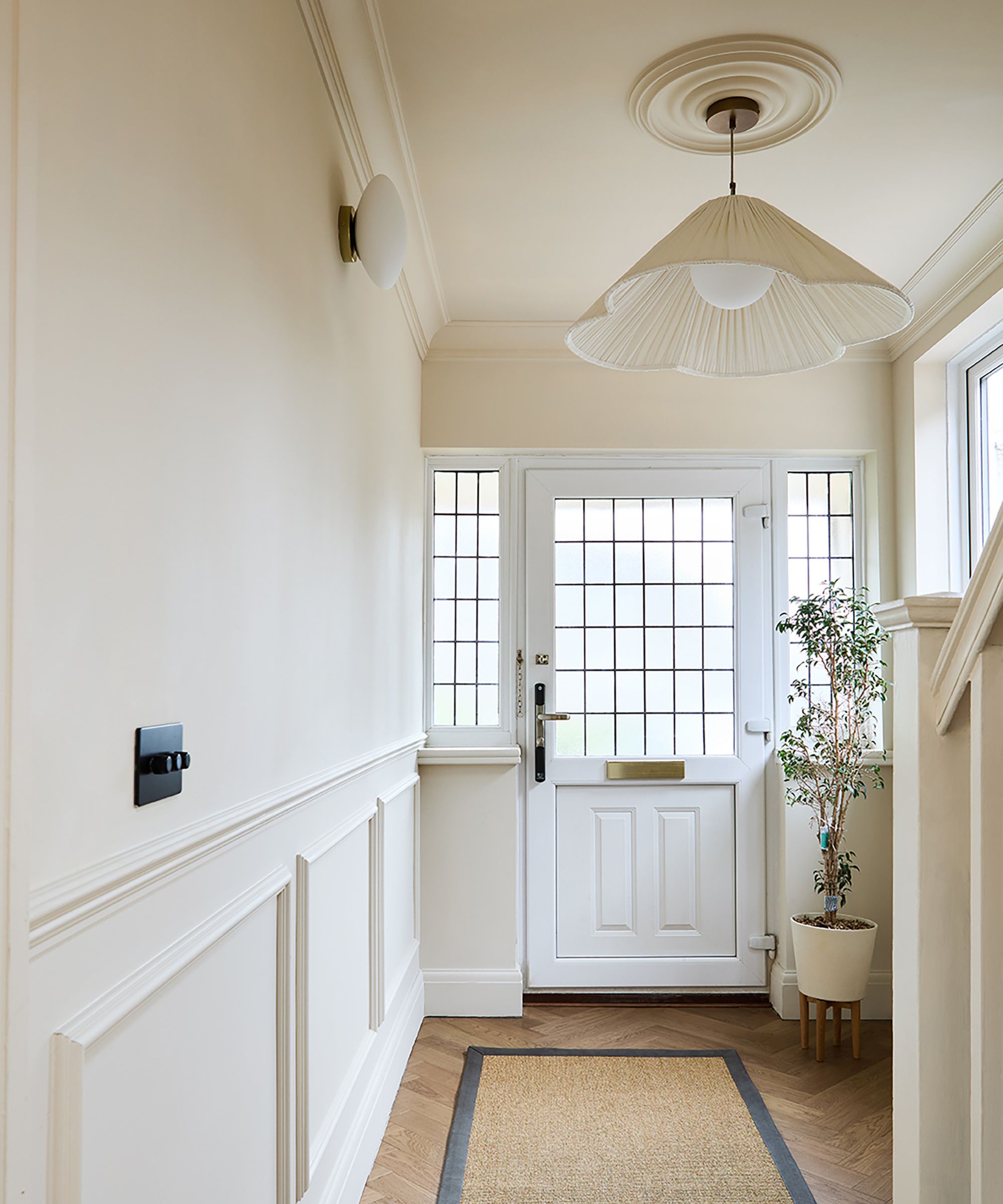
“High ceilings in Victorian hallways are a gift,” says Keely Smith, interior designer. “They let you work with larger light fixtures that make a statement. I like using pendant lights made with vintage glass and warm-toned finishes. They keep the old-world charm alive without feeling stuffy.”
“In a home with original Victorian character, try and look for lighting that leans into those original features, rather than an ultra-modern style which can create too much of a contrast" adds Ally Dowsing-Reynolds. "Think fluted glass and metals like antique brass, brushed gold, and bronze, which all work great in period properties.”
15. Add wall sconces to introduce softer layered light
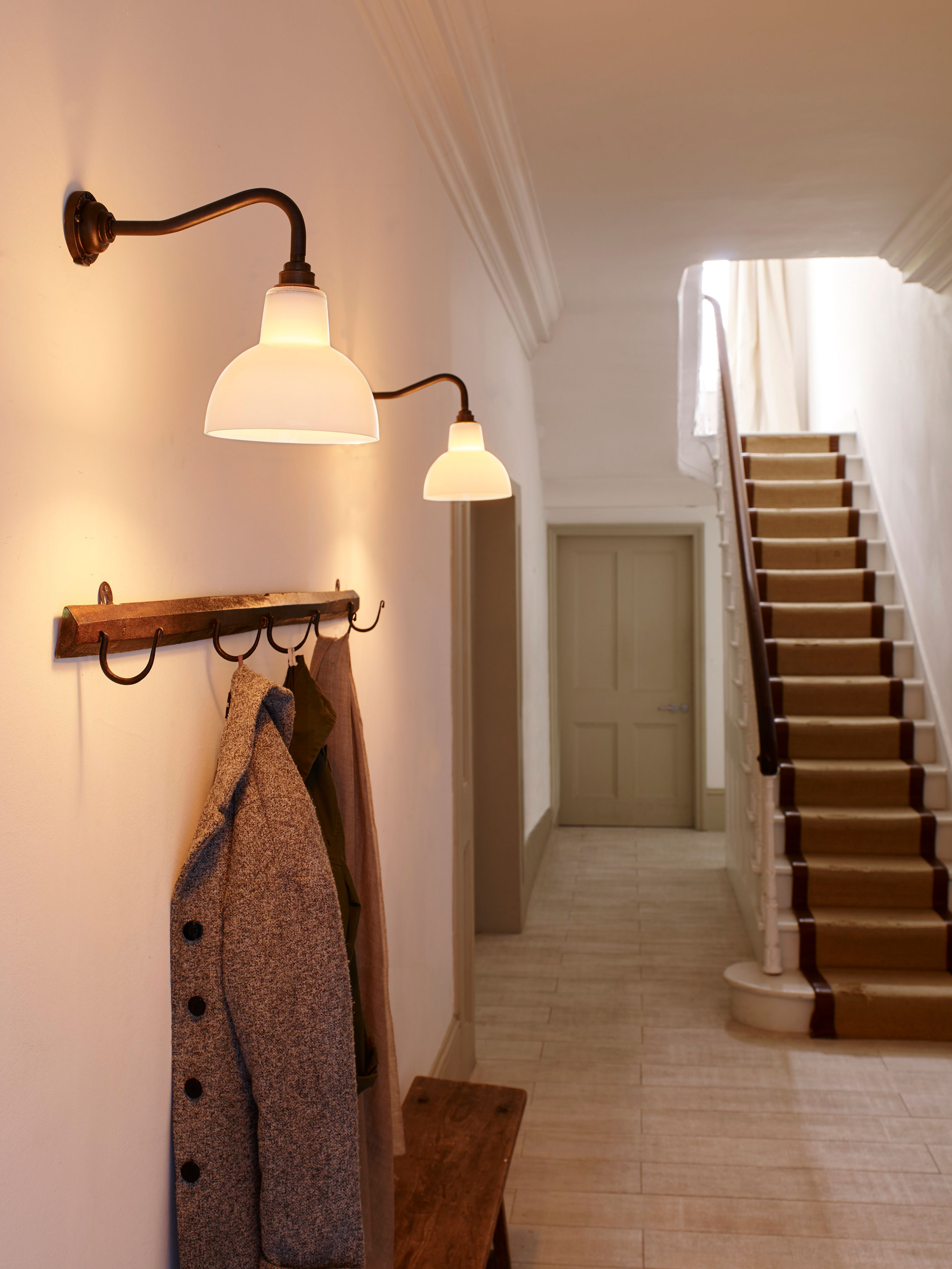
Wall sconces are an ideal hallway lighting choice, as they not only free up floor and surface space, they also offer a gentler, more flattering alternative to a single overhead fitting.
“Victorian hallways weren’t built with natural light in mind, so you often have to work around dark, narrow spaces,” explains Chris Bawden, founder of Simple Lighting. “I tend to layer a few different sources rather than rely on one overhead pendant. Wall sconces work well here – they suit the period and cast a softer, more flattering light.”

Chris Bawden is the founder of Simple Lighting, with 15+ years of experience in energy-efficient lighting, interior trends, and e-commerce growth. He’s a trusted voice on how lighting transforms spaces and how to build brands that last.
Victorian Hallway Styling Ideas
16. If budget allows, open up the hallway to maximise space

In smaller Victorian homes, hallways can feel like a pinch point – but if your layout allows, consider removing internal walls to create a more generous flow between rooms. This striking scheme by The Vawdrey House shows just how effective this approach can be. By opening up the hallway into the adjoining living area, the designers created a connected and characterful space that still feels cohesive, helped by moody green walls, bespoke joinery and classic herringbone flooring.
17. Half-panel your walls and pair it with statement wallpaper
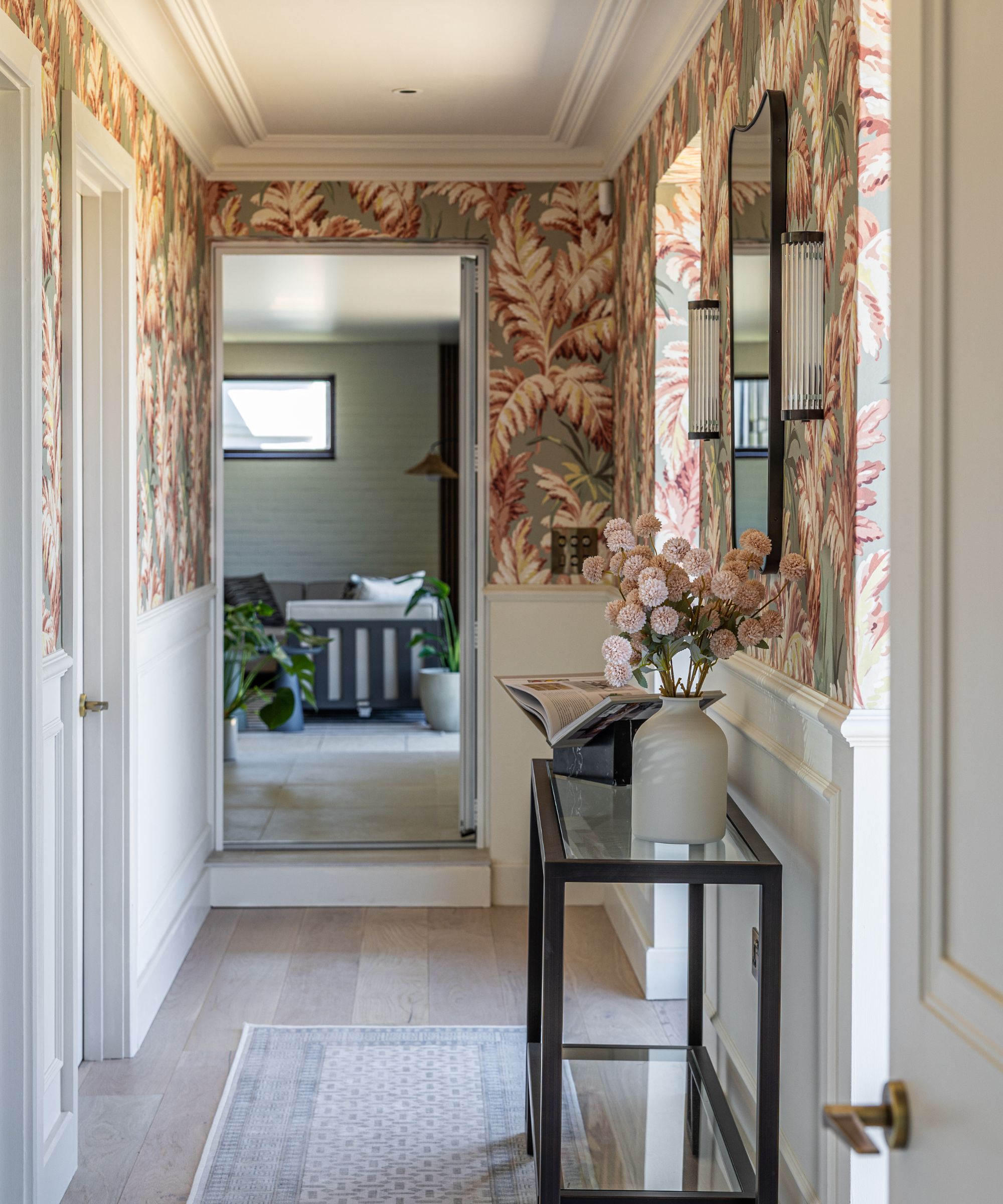
“Half-wall panels have surged in popularity in the last decade in both contemporary and traditional homes, but it was incredibly common during the Victorian era – adding elegance and detail to spaces," explains Jenna Forsdyke at Pfeiffer Design. "To recreate this heritage look in your home, or to honour panelling which is already in place, add a bold, floral wallpaper to the top half of the wall. Choose a statement colour to ensure both sections are cohesive and finally add an ornate mirror and console table for a final touch."
18. Use mirrors to reflect light and make the room feel more spacious

Mirrors are a classic design trick for making narrow hallways feel wider and brighter. In a Victorian hallway, they offer the added benefit of bouncing natural light across ornate details and period features.
“Not only are they practical – giving you a chance to check your outfit on the way out – but they also help reflect light and create a sense of space,” adds Emma Bestley. Whether you go for a modern organic shape like the one above, or a vintage gilded frame that echoes the home’s heritage, a well-placed mirror will always earn its keep.
19. Celebrate original stained glass (or recreate the look)
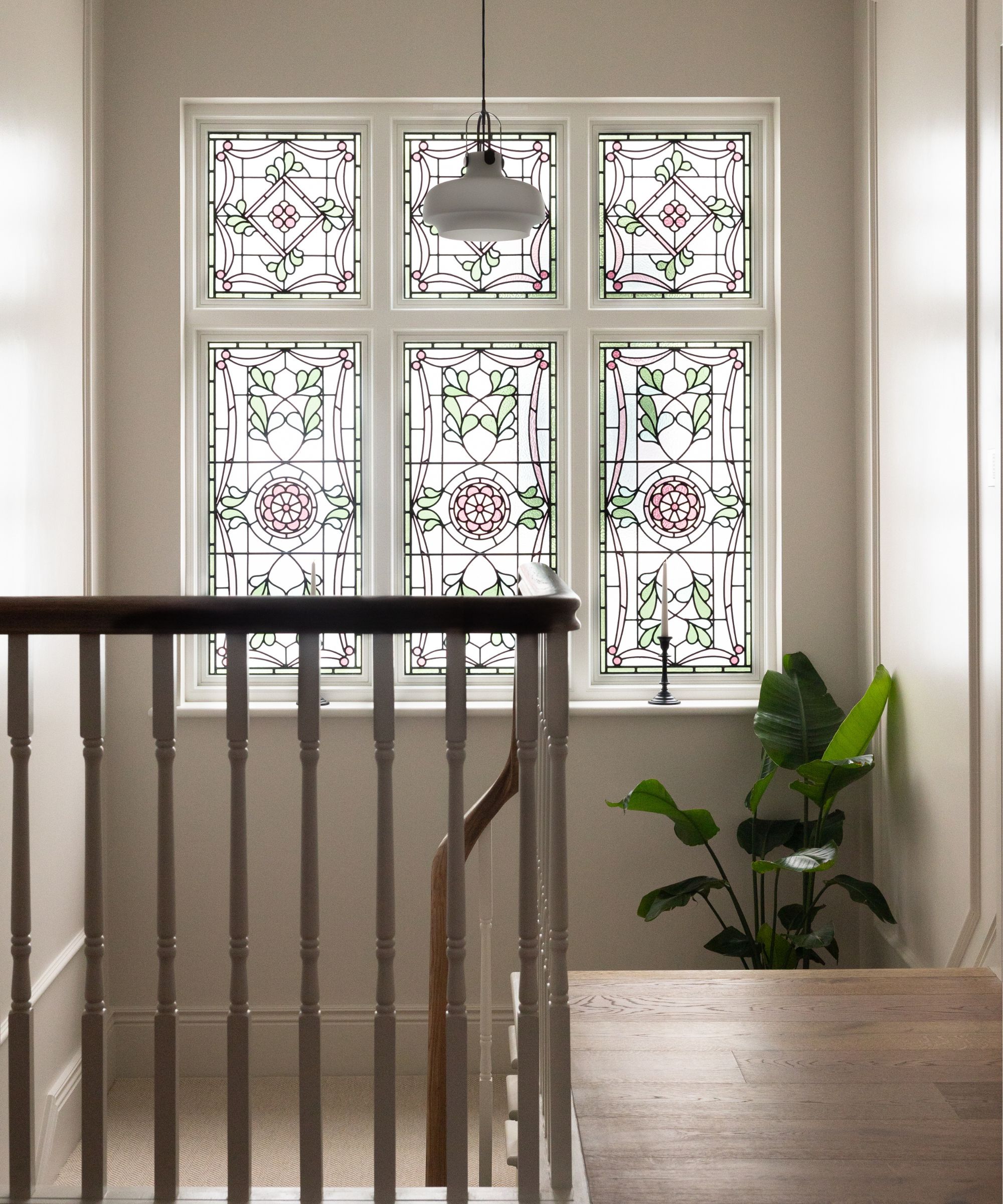
Victorian homes are often blessed with beautiful stained glass – a legacy of the era’s love of rich colour and craftsmanship. If you're lucky enough to have original panels, make them a focal point. Keep surrounding woodwork neutral to let the pattern and colour shine through. If your home doesn’t feature original glazing, fret not. It’s surprisingly easy to replicate the effect using bespoke stained glass panels, window film or even coloured overlays.
If you're planning a Victorian house extension, it’s worth taking cues from the building’s original design. Think about carrying through details like stained glass, traditional floor tiles or panelling to help the new space feel cohesive and characterful. Even in a modern addition, these touches can root your design in heritage.

Gabriella is an interiors journalist and has a wealth of experience creating interiors and renovation content. She was Homebuilding & Renovating's former Assistant Editor as well as the former Head of Solved at sister brand Homes & Gardens, where she wrote and edited content addressing key renovation, DIY and interior questions.
She’s spent the past decade crafting copy for interiors publications, award-winning architects, and leading UK homeware brands. She also served as the Content Manager for the ethical homeware brand Nkuku.
Gabriella is a DIY enthusiast and a lover of all things interior design. She has a particular passion for historic buildings and listed properties, and she is currently in the process of renovating a Grade II-listed Victorian coach house in the West Country.
